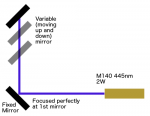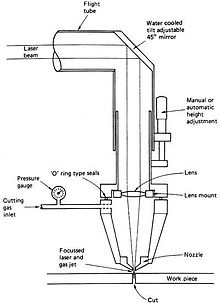Hi, all! I've been reading the forum for some time now. Finally decided to register and ask a question! Thanks in advance for the help.
I have a few M140s that I'm experimenting with. I've attached one directly to the moving head on my CNC machine and it's been neat. I also have a cheap Chinese 40w laser cutter that uses a mirrored system that I'm curious about.
If I have my M140 point directly at fixed mirror (like this one, since I'm assuming a regular old mirror doesn't work) and I focus the beam on the fixed mirror...and the fixed mirror points to a mirror that moves on direct line closer and further away from the fixed mirror (between 1-5 inches away) would my point remain focused and strong enough to etch/cut/burn?
Example attached.


I have a few M140s that I'm experimenting with. I've attached one directly to the moving head on my CNC machine and it's been neat. I also have a cheap Chinese 40w laser cutter that uses a mirrored system that I'm curious about.
If I have my M140 point directly at fixed mirror (like this one, since I'm assuming a regular old mirror doesn't work) and I focus the beam on the fixed mirror...and the fixed mirror points to a mirror that moves on direct line closer and further away from the fixed mirror (between 1-5 inches away) would my point remain focused and strong enough to etch/cut/burn?
Example attached.






